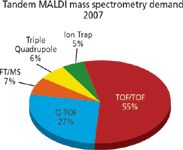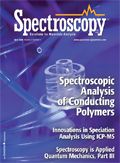Market Profile: MALDI Tandem Mass Spectrometry
First developed in the mid-1980s, matrix assisted laser desorption ionization (MALDI) added a complementary mass spectrometry ionization technique to others that were already on the market, such as electrospray ionization (ESI).
First developed in the mid-1980s, matrix assisted laser desorption ionization (MALDI) added a complementary mass spectrometry ionization technique to others that were already on the market, such as electrospray ionization (ESI). The technique was first mated to time-of-flight (TOF) mass spectrometers, and subsequently created an entirely new mass spectrometry market. However, it was not until 2000 that MALDI began to appear on tandem mass spectrometry systems, first in dedicated TOF-TOF and Q-TOF configurations, and then as more of an aftermarket product for Q-TOF, triple quadrupole, ion trap, and FT-MS instruments.

Tandem MALDI mass spectrometry demand
The advantage of MALDI ionization, primarily in comparison to ESI, which is used in LC–MS, is speed, and the fact that it is a softer ionization method. This makes MALDI better suited for larger molecules such as biomolecules and polymers. The high- throughput capability has proven to be most advantageous for the demands of pharmaceutical and biotechnology laboratories. However, these laboratories also generally demanded the additional structural and confirmatory information that can be provided by tandem mass spectrometry (MS-MS and MSn), which has led to the development of MALDI for all configurations of MS-MS.
The total market for tandem mass spectrometers that utilize MALDI was around $135 million in 2007, and is expected to see fairly robust growth. Most of this demand comes from dedicated MALDI-TOF-TOF and MALDI-Q-TOF, whose high mass range provides a strong match with MALDI. Most of the balance of demand comes from zSI-based tandem mass spectrometers that are either converted to, or alternated with, aftermarket MALDI sources. These non-TOF mass spectrometer configurations are used more for high-throughput small molecule analysis.
The foregoing data were based on SDi's market analysis and perspectives report entitled Mass Spectrometry, February 2008. For more information, contact Stuart Press, Senior Consultant, Strategic Directions International, Inc., 6242 Westchester Parkway, Suite 100, Los Angeles, CA 90045, (310) 641-4982, fax: (310) 641-8851, www.strategic-directions.com.

High-Speed Laser MS for Precise, Prep-Free Environmental Particle Tracking
April 21st 2025Scientists at Oak Ridge National Laboratory have demonstrated that a fast, laser-based mass spectrometry method—LA-ICP-TOF-MS—can accurately detect and identify airborne environmental particles, including toxic metal particles like ruthenium, without the need for complex sample preparation. The work offers a breakthrough in rapid, high-resolution analysis of environmental pollutants.
The Fundamental Role of Advanced Hyphenated Techniques in Lithium-Ion Battery Research
December 4th 2024Spectroscopy spoke with Uwe Karst, a full professor at the University of Münster in the Institute of Inorganic and Analytical Chemistry, to discuss his research on hyphenated analytical techniques in battery research.
Mass Spectrometry for Forensic Analysis: An Interview with Glen Jackson
November 27th 2024As part of “The Future of Forensic Analysis” content series, Spectroscopy sat down with Glen P. Jackson of West Virginia University to talk about the historical development of mass spectrometry in forensic analysis.
Detecting Cancer Biomarkers in Canines: An Interview with Landulfo Silveira Jr.
November 5th 2024Spectroscopy sat down with Landulfo Silveira Jr. of Universidade Anhembi Morumbi-UAM and Center for Innovation, Technology and Education-CITÉ (São Paulo, Brazil) to talk about his team’s latest research using Raman spectroscopy to detect biomarkers of cancer in canine sera.